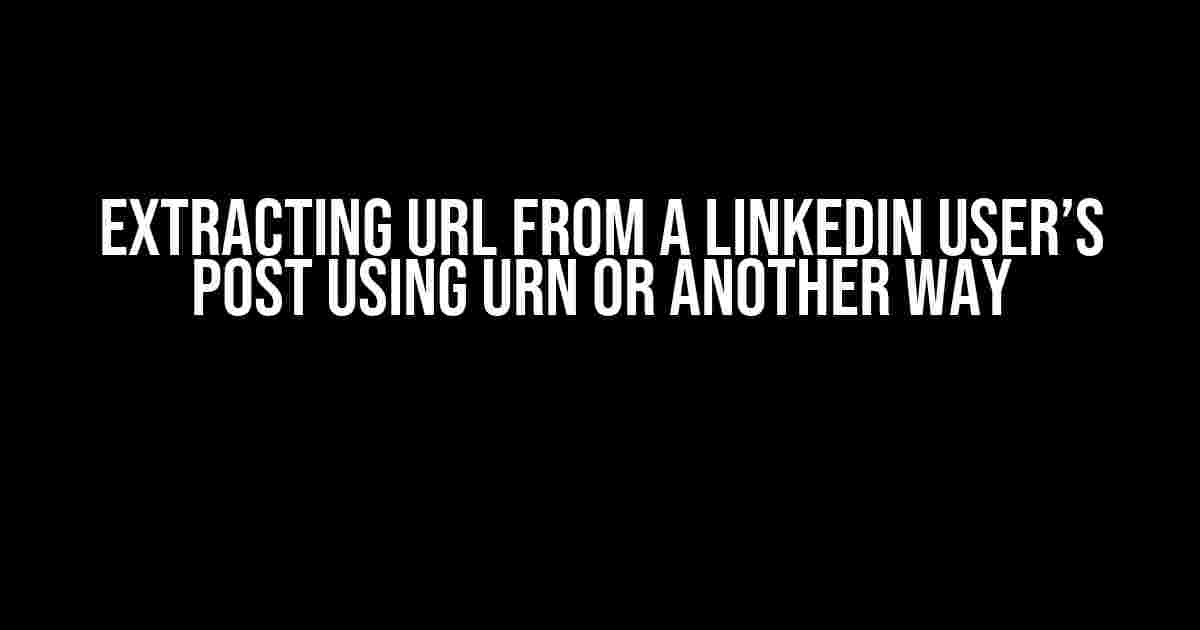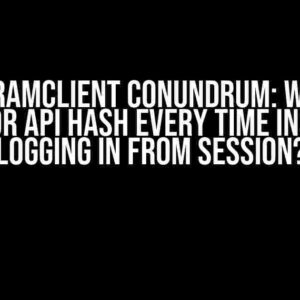Are you tired of manually extracting URLs from LinkedIn posts? Do you want to automate the process and make it more efficient? Look no further! In this article, we’ll explore how to extract URLs from a LinkedIn user’s post using URN or alternative methods.
What is URN?
URN stands for Uniform Resource Name, which is a unique identifier for resources on the internet. In the context of LinkedIn, URN is used to identify and retrieve specific posts, including their URLs. But how do we extract these URLs using URN?
Method 1: Extracting URL using URN
To extract a URL using URN, you’ll need to follow these steps:
- Identify the LinkedIn post you want to extract the URL from.
- Copy the post’s URN from the URL bar. The URN typically starts with “urn:li:activity:” followed by a series of numbers and letters.
- Use the LinkedIn API or a third-party tool to retrieve the post’s metadata using the URN. You can do this by sending an HTTP request to the LinkedIn API endpoint.
- Parse the response to extract the URL from the post’s metadata.
// Example HTTP request to retrieve post metadata
GET https://api.linkedin.com/v2/activities/{URN}
In the response, look for the “originalUrl” field, which contains the extracted URL.
{
"originalUrl": "https://example.com"
}
Method 2: Extracting URL using Regular Expressions
Another way to extract URLs from LinkedIn posts is by using regular expressions. This method involves scraping the post’s HTML content and extracting the URL using a regex pattern.
Here’s an example of how to do it:
// Import required libraries
import requests
from bs4 import BeautifulSoup
import re
// Send HTTP request to retrieve post HTML content
response = requests.get("https://www.linkedin.com/feed/update/urn:li:activity:1234567890")
// Parse HTML content using BeautifulSoup
soup = BeautifulSoup(response.content, "html.parser")
// Find the post content container
post_container = soup.find("div", {"class": "feed-update-v2__content"})
// Extract URL using regex pattern
url_pattern = re.compile(r"https?:\/\/[^\s]+")
urls = url_pattern.findall(post_container.text)
// Print extracted URL
print(urls[0])
Method 3: Extracting URL using a Third-Party Library
If you don’t want to write code to extract URLs, you can use a third-party library like linkedin-scraper. This library provides a simple way to extract URLs from LinkedIn posts.
// Install linkedin-scraper library
pip install linkedin-scraper
// Import library
from linkedin_scraper import LinkedInScraper
// Create a scraper instance
scraper = LinkedInScraper()
// Extract URL from post
post_url = scraper.get_post_url("https://www.linkedin.com/feed/update/urn:li:activity:1234567890")
// Print extracted URL
print(post_url)
Challenges and Limitations
While extracting URLs from LinkedIn posts can be useful, there are some challenges and limitations to consider:
- Rate Limiting**: LinkedIn API has rate limits to prevent abuse. Make sure to handle rate limiting to avoid getting blocked.
- Post Visibility**: If the post is not publicly visible, you may not be able to extract the URL using the methods mentioned above.
- HTML Structure**: LinkedIn’s HTML structure can change, which may break your regex pattern or parsing code.
Best Practices
To ensure you’re extracting URLs efficiently and effectively, follow these best practices:
- Use the LinkedIn API**: When possible, use the LinkedIn API to extract URLs. It’s more reliable and efficient than scraping HTML content.
- Handle Errors**: Implement error handling to handle cases where the URL cannot be extracted or the API returns an error.
- Respect Rate Limits**: Make sure to handle rate limiting to avoid getting blocked by LinkedIn.
Conclusion
Extracting URLs from LinkedIn user’s posts can be a powerful way to automate tasks and extract valuable information. By using URN, regular expressions, or third-party libraries, you can efficiently extract URLs from LinkedIn posts. Remember to respect rate limits, handle errors, and follow best practices to ensure your URL extraction process runs smoothly.
| Method | Description | Pros | Cons |
|---|---|---|---|
| URN | Extract URL using LinkedIn API and URN | Efficient, reliable, and official way to extract URLs | Requires API access and knowledge of API endpoints |
| Regular Expressions | Extract URL using regex pattern from HTML content | Flexible and can be used with other platforms | May break if HTML structure changes, and requires HTML scraping |
| Third-Party Library | Extract URL using a third-party library like linkedin-scraper | Easy to use and doesn’t require API access | May not be as reliable as using the LinkedIn API, and depends on the library’s maintenance |
Choose the method that best suits your needs and requirements. Happy URL extracting!
Frequently Asked Question
Get ready to unravel the mysteries of extracting URLs from LinkedIn user’s posts using URN or other ways!
Can I extract URLs from LinkedIn user’s posts using URN?
Yes, you can use URN ( Uniform Resource Name) to extract URLs from LinkedIn user’s posts. URN is a unique identifier that can be used to identify a resource, including URLs.
What are the benefits of using URN to extract URLs from LinkedIn user’s posts?
Using URN to extract URLs from LinkedIn user’s posts offers several benefits, including increased accuracy, ease of use, and flexibility. URN is also a standardized way of identifying resources, making it a reliable approach.
Are there any alternative ways to extract URLs from LinkedIn user’s posts besides using URN?
Yes, there are alternative ways to extract URLs from LinkedIn user’s posts besides using URN. For example, you can use APIs, web scraping, or regular expressions to extract URLs. Each approach has its own strengths and limitations, and the choice of approach depends on your specific requirements and constraints.
Can I extract URLs from LinkedIn user’s posts programmatically using APIs?
Yes, you can extract URLs from LinkedIn user’s posts programmatically using APIs. LinkedIn provides APIs that allow you to access and extract data from user’s posts, including URLs. However, you need to comply with LinkedIn’s API terms and conditions, and ensure that you have the necessary permissions and access rights.
Do I need any permissions or access rights to extract URLs from LinkedIn user’s posts?
Yes, you may need permissions or access rights to extract URLs from LinkedIn user’s posts, depending on the approach you use. For example, if you use APIs, you need to have a LinkedIn developer account and comply with API terms and conditions. If you use web scraping, you may need to obtain permission from the user or comply with website terms of use.




